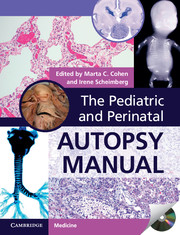Book contents
- Frontmatter
- Contents
- List of contributors
- Foreword
- Preface
- Acknowledgments
- 1 Perinatal autopsy, techniques, and classifications
- 2 Placental examination
- 3 The fetus less than 15 weeks gestation
- 4 Stillbirth and intrauterine growth restriction
- 5 Hydrops fetalis
- 6 Pathology of twinning and higher multiple pregnancy
- 7 Is this a syndrome? Patterns in genetic conditions
- 8 The metabolic disease autopsy
- 9 The abnormal heart
- 10 Central nervous system
- 11 Significant congenital abnormalities of the respiratory, digestive, and renal systems
- 12 Skeletal dysplasias
- 13 Congenital tumors
- 14 Complications of prematurity
- 15 Intrapartum and neonatal death
- 16 Sudden unexpected death in infancy
- 17 Infections and malnutrition
- 18 Role of MRI and radiology in post mortems
- 19 The forensic post mortem
- 20 Appendix tables
- Index
- References
2 - Placental examination
Published online by Cambridge University Press: 05 September 2014
- Frontmatter
- Contents
- List of contributors
- Foreword
- Preface
- Acknowledgments
- 1 Perinatal autopsy, techniques, and classifications
- 2 Placental examination
- 3 The fetus less than 15 weeks gestation
- 4 Stillbirth and intrauterine growth restriction
- 5 Hydrops fetalis
- 6 Pathology of twinning and higher multiple pregnancy
- 7 Is this a syndrome? Patterns in genetic conditions
- 8 The metabolic disease autopsy
- 9 The abnormal heart
- 10 Central nervous system
- 11 Significant congenital abnormalities of the respiratory, digestive, and renal systems
- 12 Skeletal dysplasias
- 13 Congenital tumors
- 14 Complications of prematurity
- 15 Intrapartum and neonatal death
- 16 Sudden unexpected death in infancy
- 17 Infections and malnutrition
- 18 Role of MRI and radiology in post mortems
- 19 The forensic post mortem
- 20 Appendix tables
- Index
- References
Summary
Introduction
The placenta is a remarkable organ whose importance has been recognized throughout the ages by various cultural rituals, which include burial or ingestion. Many cultures, in fact, believe that the placenta is a living being or that it has a spiritual power over the future lives of an infant or its parents. These beliefs are a reflection of important biologic truths. In reality, the placenta is the central participant in the birth triad, playing a vital role throughout pregnancy as a mediator between a mother and her child. As such, it is an outstanding reflection of the intrauterine environment. Because it can be examined in ways that the mother and infant cannot, the placenta is an important source of information to explain pregnancy outcomes and to guide postpartum management. Examination of the placenta should be performed in the presence of any pregnancy or delivery complications, fetal abnormalities and stillbirth, or when gross placental abnormalities are seen at delivery.
Before embarking on the journey to impart information about both normal and abnormal placentas, a word about the reference list is appropriate. General references for each of the primary topics of discussion and summary tables are provided in order to allow the reader to gain a more in-depth understanding of the topic. In addition, the first citations are excellent references for those who see placentas often, or infrequently [1,2].
Placental anatomical and functional structure
On section, the placenta may be seen as a house with a roof, supporting columns, floor, and a system of fountains sprouting from the floor (Figure 2.1). The roof is composed of several layers, including the amniotic epithelium (i.e., the shingles), and the chorion, and its supporting mesenchymal tissue (the wood of the roof). This together is called the amniochorionic membrane.
The supporting columns are the villi, which are large toward the chorionic plate, and become smaller as they undergo further and further sub-branching as gestation progresses. Progressive branching of the villous tree may be thought of as a normal, continuous mechanism of adaptation of the placenta to increasing nutritional/oxygenation demands by a growing fetus. The progressive sub-branching increases the absorptive/exchange surface area of the placenta. The villi arising from a single fetal artery/vein pair of vessels is called a cotyledon.
- Type
- Chapter
- Information
- The Pediatric and Perinatal Autopsy Manual , pp. 17 - 46Publisher: Cambridge University PressPrint publication year: 2000
References
- 3
- Cited by



